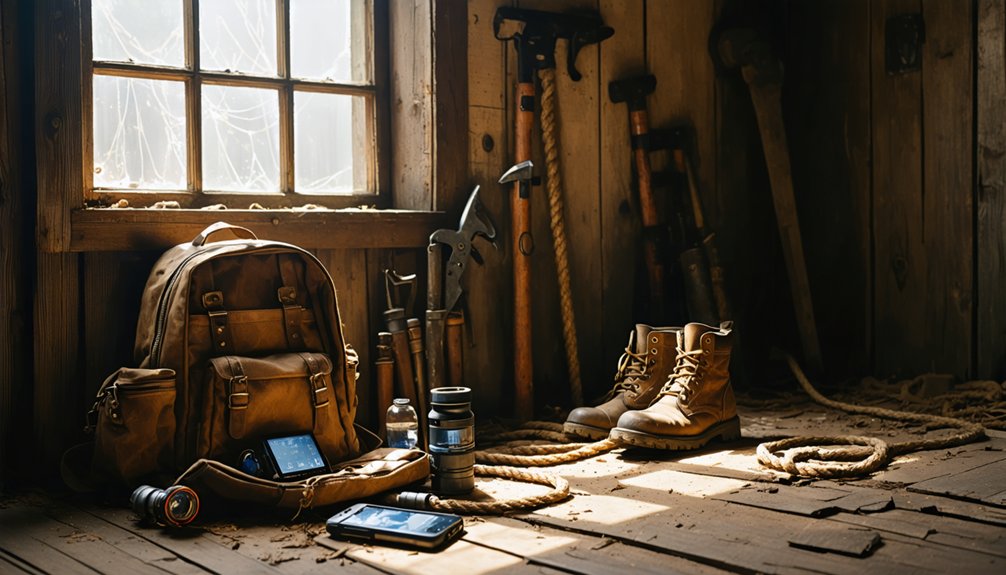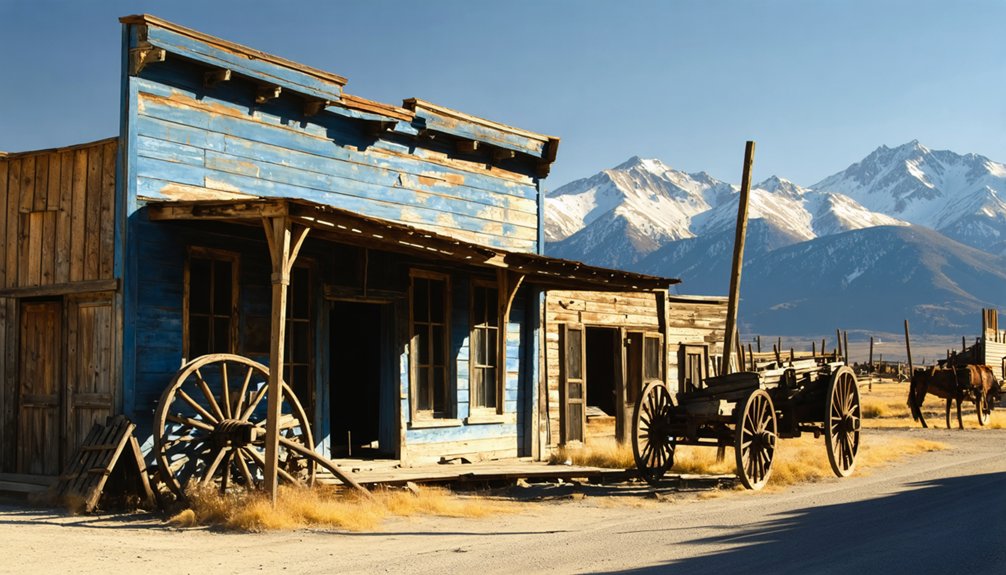Discover America’s haunting Old West ghost towns by consulting historical USGS maps and specialized state resources from Nevada and Texas. Plan routes with seasonal accessibility in mind, and pack essential safety gear including respiratory protection and offline navigation tools. Always assess structural hazards before entering abandoned buildings and obtain proper permissions for access. Photograph with care, using tripods rather than leaning against fragile walls. The 3,800+ documented ghost towns await with their untold stories of frontier boom-and-bust cycles.
Key Takeaways
- Research using historical USGS maps to identify abandoned settlements and plan routes that connect multiple ghost towns.
- Pack essential safety gear including respiratory protection, hard hats, first aid supplies, and multiple light sources.
- Verify authenticity by examining hand-driven nails, uneven floorboards, and natural weathering patterns in structures.
- Obtain proper permissions from landowners and understand legal frameworks for accessing privately owned ghost town sites.
- Document your findings with wide-angle photography using natural light, and never disturb artifacts from their original positions.
Finding the Best Ghost Towns on Historical Maps

While many travelers rely on modern GPS technology, historical maps remain the quintessential resource for serious ghost town exploration.
For thorough historical map analysis, consult the USGS topographic series from 1900-1980, which reveals settlements that have vanished from contemporary landscapes. Focus your attention on manmade structures—mines, tunnels, rail stations—that signal abandoned communities. When exploring these sites, remember to respect historical significance and leave no trace to preserve these valuable locations for future visitors. By adding Gaia GPS Premium to your toolkit, you can access comprehensive historical topo maps spanning multiple decades.
The most productive research combines vintage map bases with transparent modern overlays, allowing you to precisely identify ghost town geography through comparative visualization.
Layering historical cartography with contemporary mapping creates the perfect navigational tool for pinpointing America’s forgotten communities.
States with rich concentrations like Texas (550 ghost towns) and Nevada offer specialized resources worth obtaining. University digital collections and the National Archives provide scholarly-grade maps documenting mining booms and railroad expansions that defined the 19th-century Western frontier—cartographic windows into America’s transient settlements.
Planning Your Route Through America’s Forgotten Mining Towns
Armed with historical maps and cartographic resources, you’ll now face the methodical task of plotting an excellent route through America’s forgotten mining settlements.
Focus your route enhancement on regional concentrations—the mineral-rich Western states offer exceptional density, while Pennsylvania’s coal country provides concentrated historical sites in the East.
Consider seasonal accessibility; summer and early fall provide optimal conditions for high-elevation towns where winter renders roads impassable. Texas and California have the highest number of ghost towns, providing ample opportunities for extended exploration trips.
Western Mining History’s thorough mapping proves invaluable when connecting multiple sites, particularly in states like Colorado and Nevada where ghost towns often cluster along historical transportation corridors.
When planning multi-day expeditions, account for unpaved roads requiring 4WD vehicles and areas lacking cellular connectivity. Exploring Cerro Gordo in California offers insights into the darker history of mining towns known for both wealth and violence.
Incorporate local attractions maintained by historical societies to contextualize your journey through America’s extractive industrial past.
Essential Safety Gear and Supplies for Remote Explorations

When venturing into America’s abandoned mining settlements, your survival depends on carrying an extensive gear pack that includes respiratory protection, first aid supplies, and redundant lighting sources.
Your awareness of structural integrity hazards—particularly in mine shafts, deteriorating buildings, and unstable foundations—will determine whether you return with mere photographs or serious injuries.
Navigation requires more sophisticated tools than standard maps alone, as you’ll need offline GPS capabilities, physical compasses, and communication devices that function beyond cellular coverage areas. Always mark your starting point on physical paper maps to ensure you can navigate back safely even when electronic devices fail. It’s crucial to inform a trusted friend or family member about your exploration plans before departing for remote ghost towns.
Survival Pack Essentials
Exploring abandoned ghost towns in remote areas requires thorough preparation with essential survival gear to guarantee your safety during these historical adventures.
You’ll need multiple illumination sources—a headlamp, flashlight, and backup LED—with extra batteries for extended expeditions. Your emergency preparedness must include respiratory protection such as N95 masks to shield against potential asbestos and mold common in deteriorating structures.
Pack a detailed first aid kit containing bandages, antiseptic wipes, and basic medications for treating minor injuries in isolated locations. Carry at least two liters of water per person, supplemented with purification methods for unexpected delays. Always plan for at least three days’ worth of water and food supplies in case you become stranded in these remote locations.
Don’t underestimate the importance of protective equipment—cut-resistant gloves and sturdy hiking boots will safeguard you against the hazardous debris that litters these fascinating but potentially dangerous historical sites. A comfortable backpack solution is essential for distributing weight evenly while keeping your hands free to navigate rough terrain and document your exploration.
Structural Hazard Awareness
The structural integrity of abandoned Western ghost towns presents significant safety challenges beyond basic survival considerations. Conduct a thorough hazard assessment before entering any structure, noting rotted floorboards, false floors, and unstable support beams that may collapse without warning.
Always wear a hard hat to protect against falling debris and equip yourself with multiple light sources to navigate dark interiors safely. With approximately 17,000 abandoned mines scattered throughout Utah alone, these deteriorating sites pose serious risks to unprepared explorers.
Avoid walking through the center of rooms where floors are weakest, instead staying near walls and structural supports. Your respiratory protection is essential when encountering mold, asbestos, or toxic mineral dust.
Sturdy boots with ankle support will help prevent injuries on uneven terrain. Remember that abandoned mines may harbor deadly gases and old explosives that can spontaneously detonate—never enter sealed mine shafts. Ghost towns throughout Europe serve as powerful historical memorials of past events, much like their American counterparts.
Anyone venturing into remote ghost towns must equip themselves with navigation tools that function independently of modern technology’s limitations. Your primary resources should include traditional compass and topographic maps for accurate land navigation when GPS signals fail in mountainous terrain or remote valleys.
Supplement these fundamental tools with a fully-charged GPS device and backup power sources for technological redundancy. Map interpretation skills become vital when landmarks have deteriorated over decades of abandonment.
Consider marking your route with removable masking tape to guarantee safe return passage without damaging historical structures. A multi-tool with map-reading capabilities provides practical utility, while a headlamp with extra batteries guarantees visibility for navigation during unexpected delays.
This equipment constellation creates a robust system for maintaining spatial awareness in these forgotten territories where cellular coverage remains nonexistent.
Recognizing Authentic Structures vs. Tourist Reconstructions

When visiting Old West ghost towns, discerning authentic historical structures from modern tourist reconstructions requires careful observation of several key attributes.
Examine construction materials closely—authentic features include hand-driven nails, uneven floorboards, and pegged joints, while reconstructions typically display uniformity in materials and precision.
Authentic structures weather naturally, exhibiting inconsistent decay patterns, structural sagging, and weathered wood grain that can’t be accurately replicated.
Reconstruction signs include fresh paint, maintained exteriors, and modern fasteners.
Verify provenance through historical documentation at local museums or visitor centers. Original buildings often have documented lineage in archives or land records, while reconstructions lack continuous historical ownership.
Additionally, authentic town layouts follow irregular patterns adapted to topography, whereas tourist sites frequently feature orderly, planned arrangements reflecting contemporary design sensibilities.
Photographing Abandoned Buildings Without Causing Damage
Successful photography of abandoned structures in Old West ghost towns requires conscientious practices that preserve these fragile historical remnants while capturing their evocative essence.
Adhere to strict photography ethics by utilizing a tripod rather than leaning equipment against deteriorating walls. Never move artifacts for compositional purposes—document them exactly as found.
Implement preservation techniques by traversing carefully on solid flooring, avoiding weight on compromised structural elements. Your wide-angle lens (24mm or wider) allows thorough documentation while minimizing physical movement through delicate spaces.
When applying HDR bracketing for contrast management, position yourself strategically to avoid disturbing dust or debris.
During early morning shoots, natural light penetrating through existing apertures eliminates the need for flash photography that might accelerate material degradation.
Prioritize documentation techniques that leave no trace of your presence.

Maneuvering the complex legal landscape of ghost town access requires thorough understanding of ownership structures, preservation laws, and visitation protocols before commencing your exploration.
Conduct exhaustive title searches to establish clear property ownership, as abandoned settlements often present fragmented possession records spanning generations.
Ownership records of ghost towns typically fragment across decades, demanding meticulous title research before any exploration begins.
When pursuing visitation or acquisition, you’ll encounter varying legal frameworks depending on designation status.
Privately owned sites necessitate explicit permissions from current titleholders, while historically protected locations operate under federal, state, and tribal preservation statutes. The National Historic Preservation Act and local zoning ordinances greatly constrain development possibilities.
Should you contemplate restoration activities, prepare to navigate permit requirements from relevant historical commissions.
Infrastructure improvements—particularly utility installation—demand substantial regulatory compliance and often trigger additional governmental reviews regardless of legal permissions secured.
Uncovering Personal Stories Through Cemetery and Archive Research
Beyond the weathered facades and collapsed timber frames of ghost towns lie the poignant narratives of those who once called these settlements home, waiting to be uncovered through methodical cemetery and archival investigation.
When applying cemetery techniques, you’ll discover forgotten stories through:
- Visual inspection of landscape anomalies indicating unmarked graves
- Ground-penetrating radar surveys revealing subterranean burial patterns
- Examination of weathered inscriptions using raking light techniques
- Correlation of physical evidence with documentary sources
Archive exploration demands scrutiny of county records, newspaper obituaries, church registries, and land deeds. These textual artifacts illuminate social networks, economic conditions, and demographic patterns otherwise lost to history.
Local historical societies often maintain oral histories from descendants, providing invaluable contextual insights about individuals interred in these remote burial grounds. Through these methodologies, you’ll transcend mere observation to experience authentic connections with the West’s pioneering spirit.
Frequently Asked Questions
Can I Camp Overnight in Ghost Towns?
Like moths to forgotten lamplight, you can camp in many ghost towns. Research local camping regulations beforehand—permissions vary widely. Implement safety precautions regarding wildlife, structural hazards, and leave-no-trace practices.
Are Ghost Towns Truly Haunted or Paranormally Active?
While paranormal investigations yield mixed results, evidence for hauntings remains inconclusive. You’ll encounter compelling ghost stories, but whether phenomena are truly paranormal or merely psychological projections remains scientifically unresolved.
How Can I Tell if a Ghost Town Is Completely Abandoned?
Like a Tiktok in a saloon, complete abandonment is recognizable through dilapidated infrastructure, nature’s reclamation, absent utilities, and ghost town signs warning trespassers. Conduct historical research to verify depopulation records definitively.
What Should I Do if I Find Valuable Artifacts?
Document the artifact in situ through photographs and precise measurements. Don’t remove it without landowner permission. Legal considerations require reporting significant finds while ensuring proper artifact preservation methods are followed.
How Did People Communicate Between Isolated Mining Towns?
Like threads of copper binding the frontier’s scattered jewels, isolated mining towns were connected through telegraph systems strung along railroad lines, smoke signals, mail carriers, and informal community-based methods of information exchange.
References
- https://mapsofantiquity.com/products/1968-the-historic-west-lost-mines-and-ghost-towns-frontier-military-forts-pictorial-map
- https://devblog.batchgeo.com/ghost-towns/
- https://nvtami.com/nevada-ghost-towns-map/
- https://www.frrandp.com/p/ghost-towns-map.html
- https://www.visitcalifornia.com/road-trips/ghost-towns/
- https://www.raremaps.com/gallery/detail/63635
- https://www.geotab.com/ghost-towns/
- https://www.losethemap.com/bodie-state-park/
- https://possibleshop.com/books-maps-ghost-towns.html
- https://collections.lib.uwm.edu/digital/collection/agdm/id/36847/



